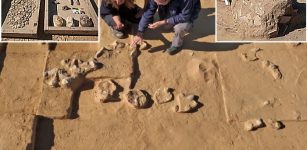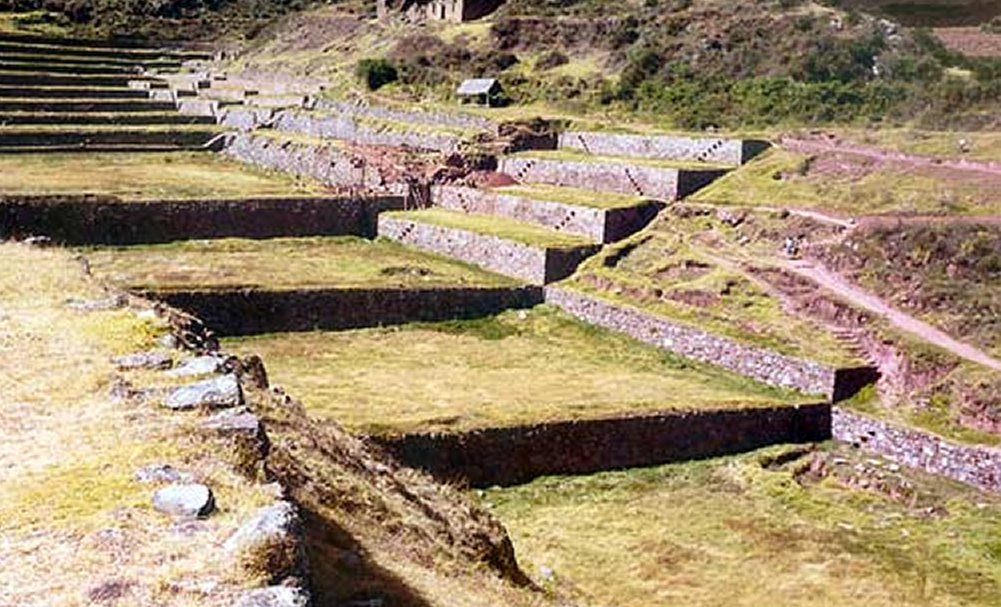Tipón (Tipon): Who Taught The Inca How To Build Artificially Irrigated Garden?
A. Sutherland - AncientPages.com - There are many unanswered questions regarding the Inca’s marvelous engineering masterpiece known as Tipón.
How did the Inca manage to reach this high level of development? What was the source of their advanced knowledge of hydraulics?
Nowhere else in Tawantinsuyu (“Land of the Four Quarters”) as the Inca used to refer to their empire, are there so well-planned and carefully finished agricultural terraces and irrigating channels as in the Tipón complex.
Cusco Tipón terraces. Source
The original name of this Inca site is lost in time; however, Dr. Luis Antonio Pardo, the prominent Peruvian historian, believes that the current name of Tipón may derive from the Quechua word ‘Tuxeuj’ (“to be boiling”). It is believed that Tipón's walled agricultural enclosure was built by earlier people of the Cusco Valley.
As narrated by Inca Garcilaso de la Vega (1539 – 1616), a chronicler and writer, apparently, Tipón was part of the royal estate belonging to Inca Yawar Huaca (Yawar Waqaq), the seventh Sapa Inca of the Kingdom of Cusco (beginning around 1380 AD).
In his book "Tipon: Water Engineering Masterpiece of the Inca Empire", Kenneth R. Wright writes:
“The balance of Tipon is mostly covered by walled terraces for both irrigated and dry land farming. The exceptions are some upper slopes too steep for terraces and a huge, smooth, volcanic rock slab that is so steep that it will not hold topsoil.
Tipon - home to one of the largest irrigation works in terraces, with many outdoor water channels. image source
The massive outer wall of Tipon, 15 to 20 feet high and nearly 4 miles long, encircles the community. The wall provided security and firmly established the perimeter of this estate.
Tipon was a perfect location for the Inca nobility to construct an estate. Its perennial spring, adjacent streams on the east and west, and fertile volcanic soils were coupled with an already walled agricultural enclosure built by earlier people of the Cusco Valley…”
At the same time, Tipon was devoted to religious ceremonies and agricultural experiments. The site that dates back to the beginning of the 15th century, is located at 3,560 meters above sea level, about 23 km southeast of Cusco, in the district of Oropesa (province of Quispicanchis), along the Cusco-Puno road.
It covers 239 hectares and consists of enclosures and wide agricultural terraces irrigated by a network of water channels fed by a natural spring.
Tipón - A Laboratory Of Agricultural Products
Besides being an archaeological complex, Tipón is home to one of the largest irrigation works in the terraces, with a great distribution of outdoor water channels.
This beautiful compound of agricultural terraces, long stairs and stone canals is located 20 km south of the city of Cuzco.
One can think of Tipón as the largest artificially irrigated Inca garden or rather an unusual complex of garden-like structures rising on many levels and on dozens of stone terraces.
This was a garden laboratory, probably used for experimenting with agricultural products, utilizing the various micro-climates found within the complex.
It can be assumed that Tipón was a similar place for Inca agronomists, as Moray (Moroy), famous for its oval farm terraces. Moray, located in the Sacred Valley of the Incas, has an old but very sophisticated irrigation system. Probably like in Moray, also in Tipón, the Incas experimented with the cultivation of new plant varieties of potatoes, corn, and other plants.
To these activities, they needed water that flowed through fine stone structures (aqueducts, spillways, canals and falls) and farm terraces situated at many different levels. Having proper conditions, the Inca plants could grow at different temperatures and with different sun exposure.
 The hydraulic engineering of the Tipon fountain represents a high standard of care to create an aesthetic amenity. Credits: Wright Water Engineer
The hydraulic engineering of the Tipon fountain represents a high standard of care to create an aesthetic amenity. Credits: Wright Water Engineer
Therefore, the terraces rise from the bottom of the valley to its upper edge, while water flows here through aqueducts and canals, freely adjusted.
Centuries ago, the Tipón ingenious complex was most likely destroyed by the Incas themselves, who did not want to leave it in the hands of the Spaniards.
After many years, the complex was reconstructed and restored to its former glory. Tipón was once an important, specially protected place and it is evidenced by a large, oval fort that rises on the northern flank of the complex.
Written by – A. Sutherland - AncientPages.com Senior Staff Writer
Updated on January 20, 2024
Copyright © AncientPages.com All rights reserved. This material may not be published, broadcast, rewritten or redistributed in whole or part without the express written permission of AncientPages.com
Expand for referencesMore From Ancient Pages
-
 Mystery Of Prehistoric Gigantic Hill Figures Of England
Featured Stories | Sep 20, 2018
Mystery Of Prehistoric Gigantic Hill Figures Of England
Featured Stories | Sep 20, 2018 -
 Huge Ancient Ceramic Workshop With Hundreds Of Stunning Artifacts Solves An Archaeological Mystery In Israel
Archaeology | Dec 14, 2020
Huge Ancient Ceramic Workshop With Hundreds Of Stunning Artifacts Solves An Archaeological Mystery In Israel
Archaeology | Dec 14, 2020 -
 Secrets Of Mona’s Caves: Rock Art Reveals Ancient People Were Ahead Of Their Time Long Before The Arrival Of Columbus
Archaeology | Nov 4, 2017
Secrets Of Mona’s Caves: Rock Art Reveals Ancient People Were Ahead Of Their Time Long Before The Arrival Of Columbus
Archaeology | Nov 4, 2017 -
 Fionn Mac Cumhail: Legendary Irish Hero, Clairvoyant And Leader Of Fianna Warriors
Celtic Mythology | Oct 11, 2019
Fionn Mac Cumhail: Legendary Irish Hero, Clairvoyant And Leader Of Fianna Warriors
Celtic Mythology | Oct 11, 2019 -
 Secrets Of The Chephren Pyramid And Its Unknown Mysterious Force
Featured Stories | Mar 20, 2015
Secrets Of The Chephren Pyramid And Its Unknown Mysterious Force
Featured Stories | Mar 20, 2015 -
 Evidence Of Brain Surgery Performed 3,000 Years Ago Discovered In Tel Megiddo, Israel
Archaeology | Feb 23, 2023
Evidence Of Brain Surgery Performed 3,000 Years Ago Discovered In Tel Megiddo, Israel
Archaeology | Feb 23, 2023 -
 Calçoene – Amazon Stonehenge And The Mysterious Amapán Megalithic Culture
Civilizations | Feb 14, 2018
Calçoene – Amazon Stonehenge And The Mysterious Amapán Megalithic Culture
Civilizations | Feb 14, 2018 -
 Neanderthal-Denisovan Ancestors Interbred With ‘Superarchaic’ Population 700,000 Years Ago
Archaeology | Feb 24, 2020
Neanderthal-Denisovan Ancestors Interbred With ‘Superarchaic’ Population 700,000 Years Ago
Archaeology | Feb 24, 2020 -
 Thousands Magnificent Jade Artifacts Discovered In Han Dynasty Tombs – China’s Golden Age In New Light
Archaeology | Jul 23, 2020
Thousands Magnificent Jade Artifacts Discovered In Han Dynasty Tombs – China’s Golden Age In New Light
Archaeology | Jul 23, 2020 -
 Lunar Society: Great Scientists Of The 18th Century Who Changed The World
Featured Stories | Jul 13, 2018
Lunar Society: Great Scientists Of The 18th Century Who Changed The World
Featured Stories | Jul 13, 2018 -
 Ostrich Eggs Dated More Than 4,000 Years Discovered In Negev Desert Of Southern Israel
Archaeology | Jan 13, 2023
Ostrich Eggs Dated More Than 4,000 Years Discovered In Negev Desert Of Southern Israel
Archaeology | Jan 13, 2023 -
 Ancient Mystery In The Alpes Remains Unsolved Because Of Contradicting Information
Featured Stories | May 15, 2018
Ancient Mystery In The Alpes Remains Unsolved Because Of Contradicting Information
Featured Stories | May 15, 2018 -
 Facial Reconstruction Of A 75,000-Year-Old Neanderthal Woman From Shanidar Cave
Archaeology | May 3, 2024
Facial Reconstruction Of A 75,000-Year-Old Neanderthal Woman From Shanidar Cave
Archaeology | May 3, 2024 -
 Epona – One Of The Oldest And Widely Known Celtic Deities
Celtic Mythology | Feb 26, 2018
Epona – One Of The Oldest And Widely Known Celtic Deities
Celtic Mythology | Feb 26, 2018 -
 Kallikantzaroi: Naughty Nocturnal Goblins Emerge From Underground Only During Twelve Days Of Christmas
Christmas Traditions | Dec 17, 2019
Kallikantzaroi: Naughty Nocturnal Goblins Emerge From Underground Only During Twelve Days Of Christmas
Christmas Traditions | Dec 17, 2019 -
 Voice Belonging To 3,000-Year-Old Egyptian Mummified Priest – Recreated
Archaeology | Jan 28, 2020
Voice Belonging To 3,000-Year-Old Egyptian Mummified Priest – Recreated
Archaeology | Jan 28, 2020 -
 Cremation In The Near East Dates Back To 7,000 B.C.
Archaeology | Aug 13, 2020
Cremation In The Near East Dates Back To 7,000 B.C.
Archaeology | Aug 13, 2020 -
 Evidence Of Copper Processing Unearthed At Archaeological Site In Oman
Archaeology | Mar 6, 2024
Evidence Of Copper Processing Unearthed At Archaeological Site In Oman
Archaeology | Mar 6, 2024 -
 Gilmerton Cove: Mysterious Cave System Still Keeps Its Centuries-Old Secrets
Featured Stories | Nov 27, 2021
Gilmerton Cove: Mysterious Cave System Still Keeps Its Centuries-Old Secrets
Featured Stories | Nov 27, 2021 -
 The 100-Kilometer-Long Stone Highway That Connected Ancient Maya Cities Revealed By LIDAR
Archaeology | Feb 25, 2020
The 100-Kilometer-Long Stone Highway That Connected Ancient Maya Cities Revealed By LIDAR
Archaeology | Feb 25, 2020



